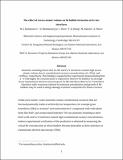The effect of excess atomic volume on He bubble formation at fcc-bcc interfaces
Author(s)
Demkowicz, Michael J.; Usov, I.; Bhattacharyya, D.; Wang, Y. Q.; Nastasi, M.; Misra, Amit; ... Show more Show less
DownloadDBUMWN_APL_open-access.pdf (2.088Mb)
OPEN_ACCESS_POLICY
Open Access Policy
Creative Commons Attribution-Noncommercial-Share Alike
Terms of use
Metadata
Show full item recordAbstract
Atomistic modeling shows that Cu–Nb and Cu–V interfaces contain high excess atomic volume due to constitutional vacancy concentrations of ∼ 5 at. % and ∼ 0.8 at. %., respectively. This finding is supported by experiments demonstrating that an approximately fivefold higher He concentration is required to observe He bubbles via through-focus transmission electron microscopy at Cu–Nb interfaces than in Cu–V interfaces. Interfaces with structures tailored to minimize precipitation and growth of He bubbles may be used to design damage-resistant composites for fusion reactors.
Date issued
2010-10Department
Massachusetts Institute of Technology. Department of Materials Science and EngineeringJournal
Applied Physics Letters
Publisher
American Institute of Physics
Citation
Demkowicz, M. J. et al. “The effect of excess atomic volume on He bubble formation at fcc–bcc interfaces.” Applied Physics Letters 97.16 (2010): 161903.
Version: Author's final manuscript
ISSN
0003-6951
1077-3118